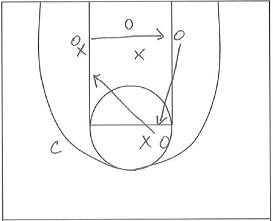Was looking for more motion offense ideas for a coaching friend and came across these great notes from a coaches clinic with Villanova's Jay Wright breaking down some of the intricacies of their Wildcat Spread offense. The whole key as you've probably guessed is spacing, anyways, enjoy...
Positions on the floor1. Two Baseline spots directly in line with the block
2. Two slots perimeter position, two feet off of the lane line extended
3. 18 feet separation between slots and baseline position
4. Post man “prime time” post position above the block, allows for cutters and room to operate for post
Perimeter players1. Three Perimeters can fill any of the three perimeter positions
2. Dribble through fill each of the four perimeter spots
Post Players1. Can fill either post position or either slot position
2. Must always be diagonal from each other
3. One post player is in the slot and one is in the perimeter.
*SPACING AND TIMING ARE VERY IMPORTANT
Basic Rules in Motion1. Post players should always be high and low in the offense
2. Screen the guard to the maintain the opposite spot
3. Our post players always screen the man in the slot
4. Ball is in the slot, ball screen
5. Ball is passed to the baseline position big man set the flare screen
6. When the ball is in the slot with the post the big man will look to duck in
7. When the ball is passed to the post the opposite big man will rip or dive to the opposite post
Rules for Perimeter Players1. After any pass guards can basket cut
2. After any pass can receive a flare screen
3. After pass guard can down screen
4. NEVER PASS AND STAND
5. Our perimeter players always screen for each other
6. Use dribble to drive or make an easy pass
Key Teaching Points in 4 out 1 in motion1. Post Ups and ball screens are our primary looks
2. Any time a guard gets a ball up top looking for post up or running a screen and roll with the slot man post
3. Set a ball Screen in the corner sets up action on weak side
4. Post entries set action up
5. All people on the perimeter must look like a shooter
6. Get your eyes on the rim
7. Use good shot selection (take easy shots)
8. Be “solid” Make the proper fundamental play
9. Take lanes - do not fight the defense
10. Communication
11. Read Opposite
Scoring Opportunities in Motion Offense1. Post Up and Rip (ball goes in the post opposite post goes to the basket) Other guards space the floor and three goes to the opposite elbow
• Post, Rip and Skip for jumper
• No jumper we post, rip, skip and seal the rip man
2. High Ball Screen
• If on a drag dribble screener makes a basket cut while opposite post fills slot position
• Baseline guards will space to the corner to spread the defense
• Guard curls post will space and opposite space will space below looking for cut opportunity
• Roll Pop and Seal (drag and hit the post coming in the slot, the post man in the prime time spot will then look to a seal in the high low duck in look).
3. Screener, cutter situations
• Four and five man are screeners and second cutters
• Ball to the corner post sets a flare screen
• Screen, curl, and pop for second cutter
4. Side Ball Screen
• Staggered double on the weak side to occupy the defense
For more on Coach Wright and Villanova's motion offense, then check out
Jay Wright's DVD on Drills for his 4-out 1-in Motion Offense. The Villanova Wildcats are currently ranked 4th in the latest AP Poll.



















